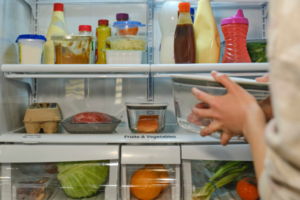Introduction:
In the hustle and bustle of daily life, efficient food organization can be a game-changer. Whether you’re a busy professional, a homemaker, or a student on a tight budget, implementing smart food organization strategies can save you valuable time and money. This article explores effective ways to streamline your food management, helping you optimize resources while enhancing convenience and reducing waste.
Importance of Smart Food Organization
Effective food organization isn’t merely about tidiness; it’s a strategy that impacts your daily routine significantly. A well-organized pantry, refrigerator, and meal planning system can lead to less food spoilage, minimized stress during meal preparation, and a clearer overview of available ingredients. This, in turn, facilitates quicker decision-making, thereby saving both time and money.
Strategize Your Pantry and Refrigerator
Begin by decluttering and organizing your pantry and refrigerator. Categorize items to ensure easy accessibility and visibility. Store frequently used items at eye level and reserve the lower and higher shelves for less frequently used products. Utilize clear containers or labeled bins to group similar items together, making it easier to identify ingredients and avoid purchasing duplicates.
Moreover, practice the “first in, first out” rule to prevent food wastage. When unpacking groceries, place newer items behind older ones, ensuring that the older items are used first. Regularly check expiration dates to discard any expired products promptly.
Meal Planning and Batch Cooking
Investing time in meal planning can significantly impact your budget and schedule. Allocate a specific day each week to plan your meals. Create a menu based on your family’s preferences, taking into account ingredients you already have to minimize additional purchases. A well-structured meal plan not only saves time but also prevents impulsive and costly takeout decisions.
Batch cooking is another time-saving technique. Prepare larger quantities of meals and freeze portions for future consumption. This approach not only reduces the time spent cooking daily but also helps in portion control and minimizes ingredient waste.
Utilize Leftovers Creatively
Transforming leftovers into new dishes is a fantastic way to save both time and money. Use leftover vegetables, meats, or grains to create soups, stir-fries, salads, or wraps. This not only reduces food waste but also adds variety to your meals without requiring additional grocery purchases.
Smart Shopping Habits
Before heading to the grocery store, take inventory of your pantry and refrigerator. Make a shopping list based on your meal plan and necessary restocks. Stick to your list to avoid unnecessary purchases. Additionally, consider buying in bulk for frequently used non-perishable items, as it often proves to be more cost-effective in the long run.
Furthermore, take advantage of sales, discounts, and coupons while shopping. However, ensure that the discounted items align with your meal plan to avoid impulse buys that might go unused.
Technology and Apps for Assistance
Numerous smartphone apps are designed specifically to aid in meal planning, grocery shopping, and food organization. These apps allow you to create shopping lists, discover recipes based on available ingredients, and track your pantry’s inventory. Leveraging technology in this manner can streamline your food management process and help you make informed decisions while saving both time and money.
Optimizing Kitchen Tools and Storage Spaces
Investing in the right kitchen tools and storage solutions can significantly contribute to efficient food organization. Utilize stackable containers, storage baskets, and versatile organizers to maximize shelf space in your pantry and refrigerator. Consider using vacuum-sealed bags for storing bulk purchases or foods prone to spoilage, thereby extending their shelf life.
Furthermore, organizing your kitchen layout plays a crucial role. Store frequently used items within easy reach and keep less commonly used appliances or utensils in accessible yet less prominent areas. This streamlined approach not only saves time but also makes cooking and meal preparation a more pleasant experience.
Mindful Consumption and Reduced Food Waste
A key aspect of smart food organization involves mindful consumption to minimize food waste. According to research, a significant amount of food gets wasted each year due to improper storage or overbuying. Be mindful of portion sizes while cooking and serving meals to avoid leftovers that might go to waste.
Moreover, learn creative ways to use food scraps. Vegetable peels, for instance, can be used to make flavorful broth, while fruit peels can be used for zest or infused water. By adopting these practices, you not only reduce waste but also maximize the use of every ingredient, contributing to both cost savings and environmental sustainability.
Community Engagement and Sharing Economy
Consider participating in community-driven initiatives such as food co-ops, community gardens, or sharing excess produce with neighbors. These activities promote a sense of community while also reducing individual expenses. Additionally, they often provide access to fresh, locally sourced produce at lower costs, contributing to healthier eating habits and reduced overall expenditure on groceries.
DIY and Preserving Techniques
Explore do-it-yourself (DIY) techniques for preserving food items. Canning, freezing, pickling, and dehydrating are effective methods to extend the shelf life of perishable foods like fruits and vegetables. By preserving surplus produce, you can create homemade jams, sauces, or dried snacks, reducing the need for store-bought equivalents and ensuring a more sustainable food supply at home.
Meal Prepping for Convenience
Incorporate meal prepping into your routine for added convenience. Spend a few hours during the weekend preparing and portioning meals for the upcoming week. This practice not only saves time but also reduces the temptation to opt for less healthy, costly takeout meals during busy weekdays.
Education and Continuous Improvement
Stay informed about food safety practices, storage guidelines, and efficient meal planning techniques. Continuous education through online resources, cookbooks, or cooking classes can enhance your food organization skills, enabling you to adapt to changing needs and preferences.
Conclusion
By optimizing kitchen tools and storage spaces, practicing mindful consumption, engaging in community initiatives, exploring DIY preservation methods, adopting meal prepping, and pursuing ongoing education, you can elevate your food organization strategies to new heights.
Smart food organization isn’t merely a one-time task; it’s an evolving process that adapts to your lifestyle, preferences, and environmental consciousness. Through these comprehensive strategies, you’ll not only save time and money but also contribute to a more sustainable and efficient food ecosystem within your home.


